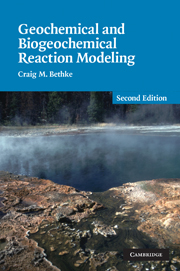Book contents
- Frontmatter
- Contents
- Preface
- Preface to first edition
- A note about software
- 1 Introduction
- 2 Modeling overview
- Part I Equilibrium in natural waters
- Part II Reaction processes
- Part III Applied reaction modeling
- 22 Hydrothermal fluids
- 23 Geothermometry
- 24 Evaporation
- 25 Sediment diagenesis
- 26 Kinetics of water–rock interaction
- 27 Weathering
- 28 Oxidation and reduction
- 29 Waste injection wells
- 30 Petroleum reservoirs
- 31 Acid drainage
- 32 Contamination and remediation
- 33 Microbial communities
- Appendix 1 Sources of modeling software
- Appendix 2 Evaluating the HMW activity model
- Appendix 3 Minerals in the LLNL database
- Appendix 4 Nonlinear rate laws
- References
- Index
23 - Geothermometry
Published online by Cambridge University Press: 05 August 2012
- Frontmatter
- Contents
- Preface
- Preface to first edition
- A note about software
- 1 Introduction
- 2 Modeling overview
- Part I Equilibrium in natural waters
- Part II Reaction processes
- Part III Applied reaction modeling
- 22 Hydrothermal fluids
- 23 Geothermometry
- 24 Evaporation
- 25 Sediment diagenesis
- 26 Kinetics of water–rock interaction
- 27 Weathering
- 28 Oxidation and reduction
- 29 Waste injection wells
- 30 Petroleum reservoirs
- 31 Acid drainage
- 32 Contamination and remediation
- 33 Microbial communities
- Appendix 1 Sources of modeling software
- Appendix 2 Evaluating the HMW activity model
- Appendix 3 Minerals in the LLNL database
- Appendix 4 Nonlinear rate laws
- References
- Index
Summary
Geothermometry is the use of a fluid's (or, although not discussed here, a rock's) chemical composition to estimate the temperature at which it equilibrated in the subsurface. The specialty is important, for example, in exploring for and exploiting geothermal fields, characterizing deep groundwater flow systems, and understanding the genesis of ore deposits.
Several chemical geothermometers are in widespread use. The silica geothermometer (Fournier and Rowe, 1966) works because the solubilities of the various silica minerals (e.g., quartz and chalcedony, SiO2) increase monotonically with temperature. The concentration of dissolved silica, therefore, defines a unique equilibrium temperature for each silica mineral. The Na–K (White, 1970) and Na–K–Ca (Fournier and Truesdell, 1973) geothermometers take advantage of the fact that the equilibrium points of cation exchange reactions among various minerals (principally, the feldspars) vary with temperature.
In applying these methods, it is necessary to make a number of assumptions or corrections (e.g., Fournier, 1977). First, the minerals with which the fluid reacted must be known. Applying the silica geothermometer assuming equilibrium with quartz, for example, would not give the correct result if the fluid's silica content is controlled by reaction with chalcedony. Second, the fluid must have attained equilibrium with these minerals. Many studies have suggested that equilibrium is commonly approached in geothermal systems, especially for ancient waters at high temperature, but this may not be the case in young sedimentary basins like the Gulf of Mexico basin (Land and Macpherson, 1992). Third, the fluid's composition must not have been altered by separation of a gas phase, mineral precipitation, or mixing with other fluids.
- Type
- Chapter
- Information
- Geochemical and Biogeochemical Reaction Modeling , pp. 341 - 356Publisher: Cambridge University PressPrint publication year: 2007
- 1
- Cited by



